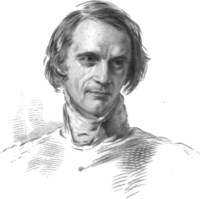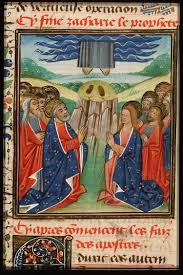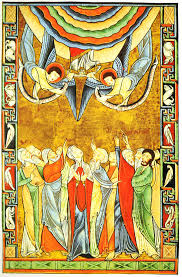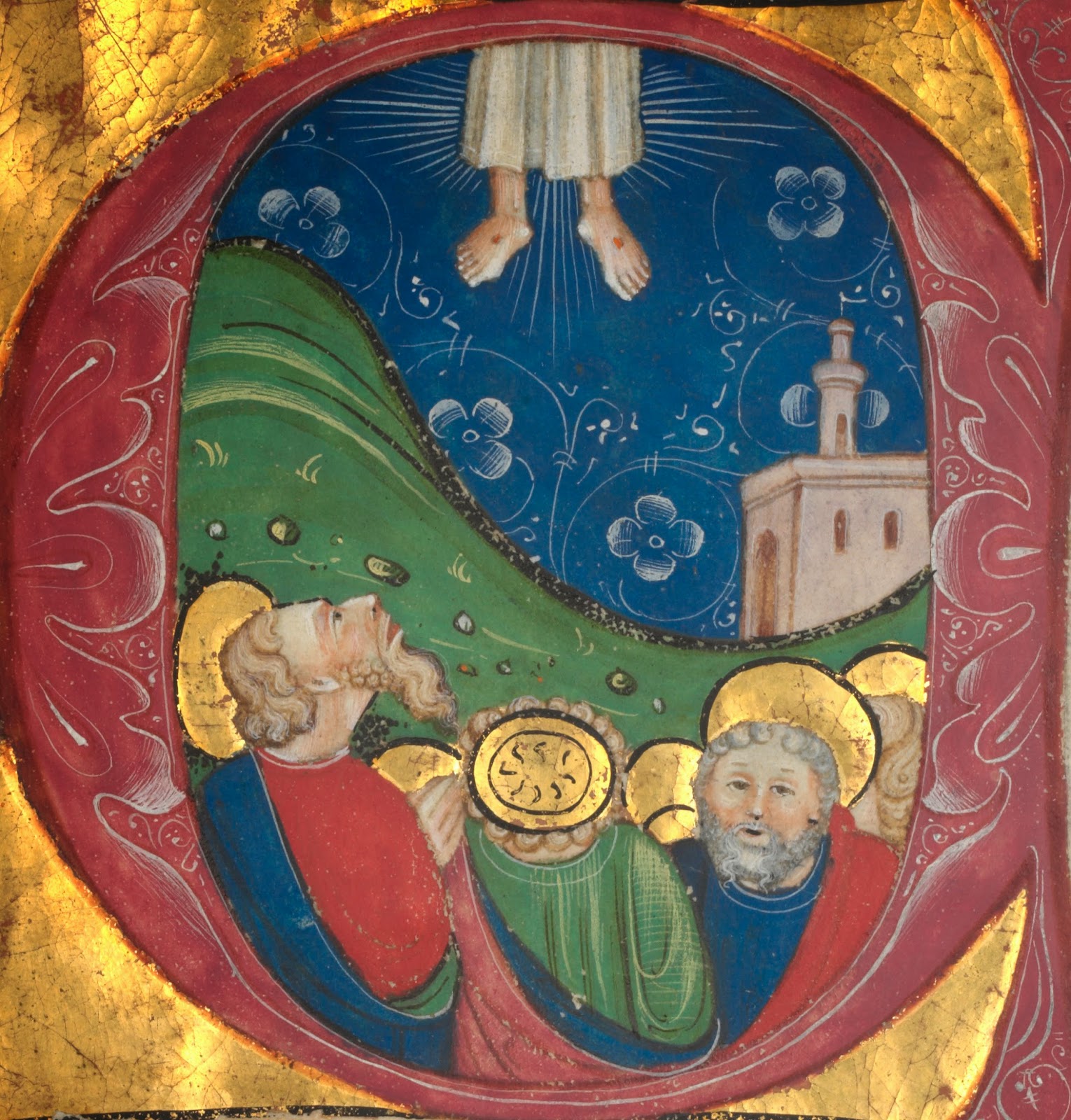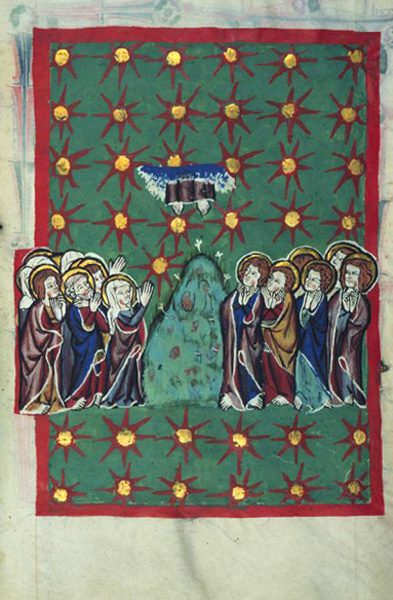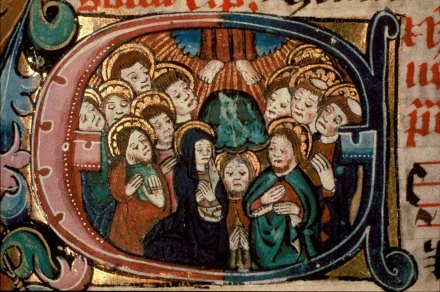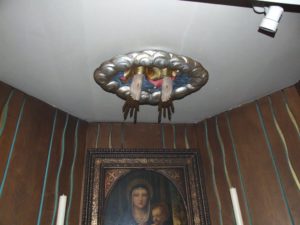Mount Calvary Church
Eutaw Street and Madison Avenue
Baltimore, Maryland
A Roman Catholic Parish of
The Personal Ordinariate of the Chair of St. Peter
Anglican Use
Rev. Albert Scharbach, Pastor
Ascension Thursday
May 10, 2018
7 PM Sung Mass
Rev. Edward V. Meeks
Christ the King Church, Towson
Celebrant and Homilist
Prelude
Prière du Christ montant vers son Père from L’Ascension, Olivier Messiaen
Hymns
Hail the day that sees Him rise (LLANFAIR)
O King most high, of earth and sky (ACH GOTT UND HERR)
See the conqueror mounts in triumph (IN BABILONE)
Anthems
Ascendit Deus, Peter Philips
Ascendit Deus in iubilatione, Henry Purcell
Common
Missa Brevis, Palestrina
Postlude
Glorificamus, John Redford
___________________________
Prelude
Prière du Christ montant vers son Père from L’Ascension, Olivier Messiaen
Although it may well be better known in its version for organ, Olivier Messiaen’s L’Ascension of 1932-1933 is the most famous of his early orchestral scores (early in this case meaning pre-Turangalîla-symphonie). Messiaen had in 1931 been appointed organist at L’Église de la Trinité, and by 1935 an organ version of L’Ascension had been finished; in truth, the work’s conception seems to lie midway between the two media: one passage may seem wholly orchestral in design and execution (even in the organ version), while another may have trickled from Messiaen’s fingers as he sat at his beloved La Trinité organ. That is not to say that the orchestral version of the work is anything but masterfully and magnificently scored, only to say that, try though he might, at that point in his life Messiaen could not wholly disassociate his music from the organ-bench upon which so much of it was first played. One major difference between the two versions must be noted: the third movement of the organ version is a completely different piece of music than the third movement of the orchestral version.
Here is Gaston Litaize on the Grandes Orgues de l’Eglise Saint Francois-Xavier in Paris. Here is the London Symphony under Leopold Stokowski.
__________________________
Hymns
Hail the day that sees Him rise (LLANFAIR)
“Hail the Day that Sees Him Rise” by Charles Wesley (1707-1788) was published in 1739 in Hymns and Sacred Poems under the title “Hymn for Ascension-Day.” The original poem comprised 10 stanzas. The stanzas in red are not used in the 1940 Hymnal
1. Hail the day that sees Him rise, Alleluia!
To His throne above the skies, Alleluia!
Christ, awhile to mortals given, Alleluia!
Reascends His native heaven, Alleluia!2. There the glorious triumph waits, Alleluia!
Lift your heads, eternal gates, Alleluia!
Christ hath conquered death and sin, Alleluia!
Take the King of glory in, Alleluia!3. Circled round with angel powers, Alleluia!
Their triumphant Lord, and ours, Alleluia!
Conqueror over death and sin, Alleluia!
Take the King of glory in! Alleluia!4. Him though highest Heav’n receives, Alleluia!
Still He loves the earth He leaves, Alleluia!
Though returning to His throne, Alleluia!
Still He calls mankind His own, Alleluia!5. See! He lifts His hands above, Alleluia!
See! He shows the prints of love, Alleluia!
Hark! His gracious lips bestow, Alleluia!
Blessings on His church below, Alleluia!6. Still for us His death He pleads, Alleluia!
Prevalent He intercedes, Alleluia!
Near Himself prepares our place, Alleluia!
Harbinger of human race, Alleluia!7. Master, (will we ever say), Alleluia!
Taken from our head to day, Alleluia!
See Thy faithful servants, see, Alleluia!
Ever gazing up to Thee, Alleluia!8. Grant, though parted from our sight, Alleluia!
Far above yon azure height, Alleluia!
Grant our hearts may thither rise, Alleluia!
Seeking Thee beyond the skies, Alleluia!9. Ever upward let us move, Alleluia!
Wafted on the wings of love, Alleluia!
Looking when our Lord shall come, Alleluia!
Longing, gasping after home, Alleluia!10. There we shall with Thee remain, Alleluia!
Partners of Thy endless reign, Alleluia!
There Thy face unclouded see, Alleluia!
Find our heaven of heavens in Thee, Alleluia!
This stanza is used as the conclusion in the 1940 Hymnal:
Lord beyond our mortal sight, Alleluia!
Raise our hearts to reach thy height, Alleluia!
There thy face unclouded see, alleluia!
Find our heaven of heaven in thee, alleluia!
Her is the Mormon Tabernacle Choir and full orchestra.
The first and second stanzas employ apostrophe, a rhetorical device in which the poet addresses an absent or inanimate object. The first addresses the day of Jesus’ ascension, the second the gates of heaven which accept Christ in glory.
The third emphasizes the true humanity of Jesus and his continued investment in the lives of those on earth, in comparison to his heavenly inheritance described in the previous lines. He is the continuous intercessor for mankind, imploring his assistance in the efforts of all to follow him in the ascent to the presence of God, leading finally to the beatific vision and eternal union with God.
Some minor textual alterations were made by Thomas Cotterill for the 1820 publication, Selection of Psalms and Hymns. The addition of “Alleluia!” at the end of each line was instigated by E.G. White for the 1852 publication of Hymns and Introits.
The next significant textual change, however, is less justified. In the first stanza, the original “Ravish’d from our wishful Eyes” is altered to “To his throne above the skies,” avoiding the pejorative or scatological implications of “ravish’d.” While this goal is met, it is at grave disservice to the evocative tone of the original text. Similarly, in the second stanza, the word “pompous” is replaced with “glorious,” again avoiding a negative meaning, but again spoiling the true meaning of the text.
The tune now associated with this text is Robert Williams’ melody LLANFAIR, which first appeared in John Parry’s collection, Peroriaeth Hyfryd (Sweet Music), in 1837. The tune name is an anglicized form of the author’s hometown in Wales, Llanfairpwllgwyngyllgogerychwyrndrobwllllandtysiliogogogoch (it’s pronounced the way it is spelled; in English it means: church of St. Mary in the hollow of white hazel near the rapid whirlpool of the Church of St. Tysillio by the red cave
). The first pairing of this text and tune is found in The English Hymnal of 1906. The harmonization found in the contemporary UM Hymnal was prepared in 1927 by David Evans. The 1941 Lutheran Hymnal presents the text to the 12th-century French tune ORIENTIS PARTIBUS and Hymns Ancient and Modern presents two alternative tunes by Wm. H. Monk and S.H. Nicholson.
______________________________________
O King most high, of earth and sky (ACH GOTT UND HERR)
O King most high of earth and sky is an anonymous hymn from the Cluniac Breviary, 1686: Supreme Rector coelitum. It was translated from Latin to English by William J. Blew.
1 O King most high of earth and sky
On prostrate death thou treadest,
And with thy blood dost mark the road
Whereby to heaven thou leadest.
2 O Christ, behold thine orphaned fold,
Which thou hast borne with anguish,
Steeped in the tide from thy rent side;
O leave us not to languish!
3 The glorious gain of all thy pain
Henceforth dost thou inherit;
Now comes the hour–then gently shower
On us thy promised Spirit!
Here is the Wakefield Cathedral Choir.
Here is the Latin hymn:
Supreme rector coelitum/ qui morta devicta potens / cruore signatum tuo / ad astra pandis semitam!
Alto benignus e Throno / et patris almi dextera / quos hic relinquis orphanos / non intrei desinas.
Parta tuis laboribus / iam tu potiris gloria. Nunc hora: / promissum Patris / Nunc mittis nobis Spiritum.
William John Blew (1808-1894) born in St. James’s, Westminster. He was educated with John Henry Newman at Great Ealing School. He graduated Wadham College, Oxford, B.A. in 1830, and M.A. 1832. On taking Holy Orders, Blew was Curate of Nuthurst and Cocking, and St. Annes, Westminster, and for a time Incumbent of St. John’s next Gravesend. Besides translation from Homer (Iliad) and Aeschylus (Agamemnon the King), and works in the Book of Common Prayer, including a paraphrase on a translation of the same in Latin, he edited the Breviarium Aberdonense 1854, and published a pamphlet on Hymns and Hymn Books, 1858; and (with Dr. H.J. Gauntlett) the Church Hymn and Tune Book, 1852, 2nd. ed. 1855.
ACH GOTT UND HERR was published in As Hymnodus Sacer, edited by Christianus Galler (Leipzig, Germany: 1625); it was adapted & harmonized by J. S. Bach.
_____________________________
See the conqueror mounts in triumph (IN BABILONE)
See the conqueror mounts in triumph was written Christopher Wordsworth and was published in his Holy Year (1862) in ten stanzas. The text views the ascending Lord being sung to by angels at heaven’s gates, recalls Christ’s suffering, death, resurrection, and ascension, and looks forward to our reign with Christ in glory. The text emphasizes not only the event of the Ascension but also its meaning for us: in Christ’s ascension, “we by faith can see” our own.
1. See the Conqueror mounts in triumph;
see the King in royal state,
riding on the clouds, his chariot,
to his heavenly palace gate!
Hark! the choirs of angel voices
joyful alleluias sing,
and the portals high are lifted
to receive their heavenly King.2. He who on the cross did suffer,
he who from the grave arose,
he has vanquished sin and Satan;
he by death has spoiled his foes.
While he lifts his hands in blessing,
he is parted from his friends;
while their eager eyes behold him,
he upon the clouds ascends.3. Thou has raised our human nature
on the clouds to God’s right hand;
there we sit in heavenly places,
there with thee in glory stand.
Jesus reigns, adored by angels;
Man with God is on the throne;
mighty Lord, in thine ascension
we by faith behold our own.This seems to be the original version:
See, the conqueror mounts in triumph;
see the king in royal state,
Riding on the clouds, His chariot,
to His heavenly palace gate.
Hark! the choirs of angel voices
joyful alleluias sing,
And the portals high are lifted
to receive their heavenly king.2. Who is this that comes in glory,
with the trump of jubilee?
Lord of battles, God of armies,
He has gained the victory.
He Who on the cross did suffer,
He who from the grave arose,
He has vanquished sin and Satan,
He by death has spoiled His foes.3. While He lifts His hands in blessing,
He is parted from His friends
While their eager eyes behold Him,
He upon the clouds ascends;
He Who walked with God and pleased Him,
preaching truth and doom to come,
He, our Enoch, is translated
to His everlasting home.4. Now our heavenly Aaron enters,
with His blood, within the veil;
Joshua now is come to Canaan,
and the kings before Him quail;
Now He plants the tribes of Israel
in their promised resting place;
Now our great Elijah offers
double portion of His grace.5. He has raised our human nature
in the clouds to God’s right hand;
There we sit in heavenly places,
there with Him in glory stand:
Jesus reigns, adored by angels;
man with God is on the throne;
Mighty Lord, in Thine ascension
we by faith behold our own.6. Holy Ghost, illuminator,
shed Thy beams upon our eyes,
Help us to look up with Stephen,
and to see beyond the skies,
Where the Son of Man in glory
standing is at God’s right hand,
Beckoning on His martyr army,
succoring His faithful band.7. See Him, who is gone before us,
heavenly mansions to prepare,
See Him, who is ever pleading
for us with prevailing prayer,
See Him, who with sound of trumpet,
and with His angelic train,
Summoning the world to judgment,
on the clouds will come again.8. Raise us up from earth to Heaven,
give us wings of faith and love,
Gales of holy aspirations
wafting us to realms above;
That, with hearts and minds uplifted,
we with Christ our Lord may dwell,
Where He sits enthroned in glory
in His heavenly citadel.9. So at last, when He appeareth,
we from out our graves may spring,
With our youth renewed like eagles,
flocking round our heavenly King.
Caught up on the clouds of Heaven,
and may meet Him in the air,
Rise to realms where He is reigning,
and may reign for ever there.10. Glory be to God the Father,
glory be to God the Son,
Dying, risen, ascending for us,
who the heavenly realm has won;
Glory to the Holy Spirit,
to one God in persons Three;
Glory both in earth and Heaven,
glory, endless glory, be.
The original text, although too long to be sung by a congregation, was considered by John Julian as “is the nearest approach in style and treatment to a Greek Ode known to us in the English language. The amount of Holy Scripture compressed into these lines is wonderful. Prophecy, Types, Historical Facts, Doctrinal Teaching, Ecstatic Praise, all are here; and the result is one grand rush of holy song.”
Wordsworth’s hymn speaks of Jesus as a conquering hero. Gone are all the aspects of humility, replaced by full glorification. Jesus’ ascension is seen like an ancient parade of triumph: “You ascended on high, leading a host of captives in your train and receiving gifts among men, even among the rebellious, that the LORD God may dwell there.”(Ps 68:18) The One who rode a donkey into Jerusalem now uses the clouds as His chariot, fulfilling the Psalter: “He lays the beams of his chambers on the waters; he makes the clouds his chariot; he rides on the wings of the wind; he makes his messengers winds, his ministers a flaming fire.”(Ps 104:3-4) The crowds that welcome Him are the LORD’s angels instead of Judeans waving palm branches. Jesus strides powerfully into His heavenly kingdom.
The second stanza continues to describe the Ascended Lord. Wordsworth alludes to Psalms 47 and 24, which are traditionally used on Ascension Day: “God has gone up with a shout, the LORD with the sound of a trumpet.”(Ps 47:5) and “Lift up your heads, O gates! And be lifted up, O ancient doors, that the King of glory may come in. Who is this King of glory? The LORD, strong and mighty, the LORD, mighty in battle!”(Ps 24:7-8) The stanza also speaks of the victory that Jesus has won over the grave, sin, and Satan. This is tied to the statement made about Jesus in Hebrews: “When Christ had offered for all time a single sacrifice for sins, he sat down at the right hand of God, waiting from that time until his enemies should be made a footstool for his feet.”(Heb 10:12-13) By His resurrection, no one can actually stand in opposition to Him. Jesus’ ascension confirms His victory.
Wordsworth includes details from the Ascension Narrative: “Then he led them out as far as Bethany, and lifting up his hands he blessed them. While he blessed them, he parted from them and was carried up into heaven.”(Lk 24:50-51) But the hymnist also begins to tie Jesus to figures from the Old Testament, using them as types. The first is Enoch, a man whose life is recorded in Genesis: “Enoch walked with God, and he was not, for God took him.”(Ge 5:24) As much as Enoch pleased God in the primeval days of the earth’s existence, Jesus surpassed him in His complete obedience to what His Father required, even the call to sacrifice. For that reason the LORD speaks of Jesus: “This is my beloved Son, with whom I am well pleased.”(Mt 3:17b) And the LORD rewards Him: “The LORD says to my Lord: ‘Sit at my right hand, until I make your enemies your footstool.’”(Ps 110:1).
Wordsworth’s tying Jesus to the figures of the Old Testament continues. He calls the Ascended Jesus our Aaron, because He is the great high priest who has gone into the heavenly sanctuary: “We have this as a sure and steadfast anchor of the soul, a hope that enters into the inner place behind the curtain, where Jesus has gone as a forerunner on our behalf, having become a high priest forever after the order of Melchizedek.”(Heb 6:19-20) His lyrics refer to Jesus’ Hebrew name Joshua, but the Ascended Jesus surpasses that ancient leader of the Hebrews into Canaan: “For if Joshua had given them rest, God would not have spoken of another day later on. So then, there remains a Sabbath rest for the people of God, for whoever has entered God’s rest has also rested from his works as God did from his.”(Heb 4:8-10) Jesus is named Elijah, the one who gave a double portion of his spirit to Elisha; this alludes to Jesus’ giving the Holy Spirit at Pentecost: “This Jesus God raised up, and of that we all are witnesses. Being therefore exalted at the right hand of God, and having received from the Father the promise of the Holy Spirit, he has poured out this that you yourselves are seeing and hearing.”(Ac 2:32-33) Through these acts, Jesus stands as the head of a long line of people whom the LORD raised up. But as the Incarnate LORD who is the Messiah, Jesus exceeds them all.
The closing stanza focuses on the theological significance of Jesus’ Ascension. Wordsworth notes the fullness of the Incarnation’s mystery: that in Jesus, human nature is now exalted into heaven. Now a Man is present in the heavenly places, since Jesus assumed humanity in order to save it: “Since therefore the children share in flesh and blood, he himself likewise partook of the same things, that through death he might destroy the one who has the power of death, that is, the devil, and deliver all those who through fear of death were subject to lifelong slavery.”(Heb 2:14-15) The result of Jesus’ work is not for one Man to be present in the world to come. In His ascension, we anticipate our blessed fate. Our shared destiny is to be raised with Jesus: “Since we have the same spirit of faith according to what has been written, ‘I believed, and so I spoke,’ we also believe, and so we also speak, knowing that he who raised the Lord Jesus will raise us also with Jesus and bring us with you into his presence.”(2Co 4:13-14) That blessed fate is ours because Jesus has died, risen, andascended. With that as our great hope, we rightly celebrate the day when His earthly work performed for us was completed. (thanks to Mount Calvary Lutheran)
Christopher Wordsworth
Christopher Wordsworth (1807-1885) was the nephew of the poet William Wordsworth. Christopher Wordsworth was an athlete, classicist, poet, and Anglican bishop of Lincoln, to which position he was appointed by Disraeli.
IN BABILONE is a traditional Dutch melody that appeared in Oude en Nieuwe Hollantse Boerenlities en Contradansen (Old and New Dutch Peasant Songs and Country Dances), c. 1710. Ralph Vaughan Williams discovered this tune as arranged by Julius Rontgen (b. Leipzig, Germany, 1855; d. Utrecht, the Netherlands, 1932) and included it in The English Hymnal (1906).
Here is an improvisation on IN BABILONE at the Church of the Advent.
____________________________
Anthems
Ascendit Deus, Peter Philips
Ps. 46:5 Ascendit Deus in jubilatione, et Dominus in voce tubae.
Dedit dona hominibus.
Alleluia.
Ps. 102:19a Dominus in caelo paravit sedem suam.
Alleluia.
Here is the NUS choir.
Peter Philips published this anthem in Cantiones Sacrae (1612).This motet is full of vitality and energy. There are brass fanfares at the in voce turba and rapid-fire alleluias characteristic of Sweelinck, The piece ends in a joyful triple meter on shouts of alleluia.
Peter Philips (c.1560–1628) was an eminent English composer, organist, and Catholic priest exiled to Flanders. He was one of the greatest keyboard virtuosos of his time, and transcribed or arranged several Italian motets and madrigals by such composers as Lassus, Palestrina, and Giulio Caccini for his instruments. Some of his keyboard works are found in the Fitzwilliam Virginal Book. Philips also wrote many sacred choral works.
Philips was born in 1560 or 1561, possibly in Devonshire or London. From 1572 to 1578 he began his career as a boy chorister at St Paul’s Cathedral in London, under the aegis of the Catholic master of choristers, Sebastian Westcott (died 1582), who had also trained the young William Byrd some twenty years earlier. Philips must have had a close relationship with his master, as he lodged in his house up to the time of Westcote’s death, and was a beneficiary of his will.
In the same year (1582), Philips left England for good, like so many others for reasons of his Catholicism, and stayed briefly in Flanders before travelling to Rome where he entered the service of Alessandro Farnese (1520–1589), with whom he stayed for three years, and was also engaged as organist at the English Jesuit College. It was here that in February 1585 he met a fellow Catholic exile, Thomas, third Baron Paget (c. 1544–1590). Philips entered Paget’s service as a musician, and the two left Rome in March 1585, travelling over several years to Genoa, Madrid, Paris, Brussels and finally Antwerp, where Philips settled in 1590 and where Paget died the same year.
After settling, Philips married and gained a precarious living by teaching the virginals to children. In 1593 he went to Amsterdam “to sie and heare an excellent man of his faculties”, doubtless Jan Pieterszoon Sweelinck, whose reputation had by then long been made. On his way back, Philips was denounced by a compatriot for complicity in a plot on Queen Elizabeth’s life, and he was temporarily imprisoned at the Hague, where he probably composed the pavan and galliard Doloroso (Fitzwilliam Virginal Book nos. LXXX and LXXXI). Philips himself translated the accusations made against him during his trial, revealing that he could by then speak Dutch. He was acquitted and released without further charges.
Philips’ fortunes took a turn for the better on his return, and in 1597 he was employed in Brussels as organist to the chapel of Albert VII, Archduke of Austria who had been appointed governor of the Low Countries in 1595. Here, after his wife – and child’s – deaths, he was ordained a priest in either 1601 or 1609 – opinions differ; in any case, he received a canonry at Soignies in 1610, and another at Béthune in 1622 or 1623. In his position at court, Philips was able to meet the best musicians of the time, including Girolamo Frescobaldi, who visited the Low Countries in 1607–1608, and his fellow-countryman John Bull, who had fled England on a charge of adultery. His nearest colleague, however, was Peeter Cornet (c. 1575–1633), organist to Archduchess Isabella, wife of Philips’ employer the archduke.
Philips died in 1628, probably in Brussels, where he was buried.
________________________
O God the King of Glory, Henry Purcell (1659-1695)
O God, the King of glory, who hast exalted thine only Son, Jesus Christ, with great triumph into heaven, we beseech Thee leave us not comfortless, but send to us thine Holy Ghost to comfort us, and exalt us to the same place where out Saviour Jesus Christ is gone before us. Amen.
Here is the Oxford Camerata.
This anthem implores God, who exalted Christ to heaven, not to leave us comfortless. The first few measures introduce the King with a nod to the French baroque overture, then uses rising phrases to convey the sense of exaltation, then arrives on a high D major chord. It then turns to striking chromatic harmonies that convey the sense of pleading for the comfort and companionship of the Holy Ghost.
____________________
Common
Missa Brevis, Palestrina
An important characteristic of Palestrina expressed clearly in this work is the use of frequent tempo changes, which are governed entirely by the changing meaning and significance of the text. Hence there is a far greater feeling of phrase than of beat and rhythm. The unity of form which overwhelms the listener reflects very clearly the peace and serenity that Palestrina himself possessed in his faith. It is not known why the mass came to be called Missa Brevis, for it is not any shorter than the usual four part Palestrina mass.
Unlike most Renaissance mass settings, it is not based on a chant melody or motet. The flowing and perfectly balanced melodic lines in the Benedictus are sung by the upper three voices. In the second Agnus Dei, the texture expands from four to five voices; the second soprano melody repeats the first soprano melody two measures later (an example of a canon). The static beauty of the final section invites contemplation of eternal realities.
_____________________
Postlude
Glorificamus, John Redford (1486-1547)
Here it is on the harpsichord.
Like those of his stylistic counterpart, William Blitheman, Redford’s compositions display a great deal of variety in their exploration of the keyboard. This composition is from the Mulliner Book.
John Redford was a major English composer, organist, and dramatist of the Tudor period. From about 1525 he was organist at St Paul’s Cathedral (succeeding Thomas Hickman). He was choirmaster there from 1531 until his death in 1547. Many of his works are represented in the Mulliner Book.
Redford is notable as one of the earliest composers, rather than improvisers, of organ music, having notated a significant quantity of keyboard music, all of it liturgical in function, based on plainchant melodies.
A Postscript on Images of the Ascension
A common medieval way of depicting the Ascension looks slightly odd to modern eyes.
